ASUS Rampage IV Black Edition Review
by Ian Cutress on January 5, 2014 10:00 AM EST- Posted in
- Motherboards
- Intel
- Asus
- X79
Readers of our motherboard review section will have noted the trend in modern motherboards to implement a form of MultiCore Enhancement / Acceleration / Turbo (read our report here) on their motherboards. This does several things – better benchmark results at stock settings (not entirely needed if overclocking is an end-user goal), at the expense of heat and temperature, but also gives in essence an automatic overclock which may be against what the user wants. Our testing methodology is ‘out-of-the-box’, with the latest public BIOS installed and XMP enabled, and thus subject to the whims of this feature. It is ultimately up to the motherboard manufacturer to take this risk – and manufacturers taking risks in the setup is something they do on every product (think C-state settings, USB priority, DPC Latency / monitoring priority, memory subtimings at JEDEC). Processor speed change is part of that risk which is clearly visible, and ultimately if no overclocking is planned, some motherboards will affect how fast that shiny new processor goes and can be an important factor in the purchase.
For reference, the ASUS Rampage IV Black Edition does enable MultiCore Enhancement when XMP is enabled.
Point Calculations - 3D Movement Algorithm Test
The algorithms in 3DPM employ both uniform random number generation or normal distribution random number generation, and vary in various amounts of trigonometric operations, conditional statements, generation and rejection, fused operations, etc. The benchmark runs through six algorithms for a specified number of particles and steps, and calculates the speed of each algorithm, then sums them all for a final score. This is an example of a real world situation that a computational scientist may find themselves in, rather than a pure synthetic benchmark. The benchmark is also parallel between particles simulated, and we test the single thread performance as well as the multi-threaded performance.
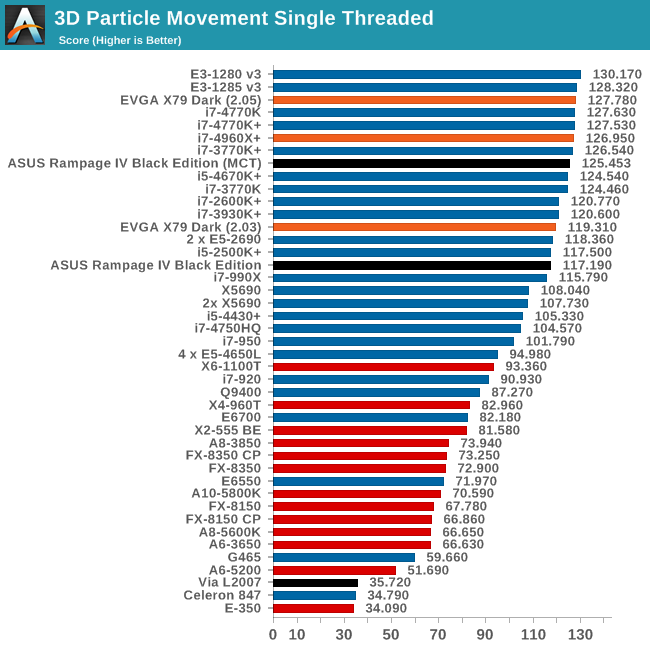
We had some issues with the single threaded test and the RIVBE – it would perform as if the CPU was stuck at 3.6 GHz (such as when MCE is turned off) even with MCE on. The benchmark did produce a high outlier at 125.4 points, which is more reasonable. I was unable to track down this issue, and it did not occur on any other benchmarks.
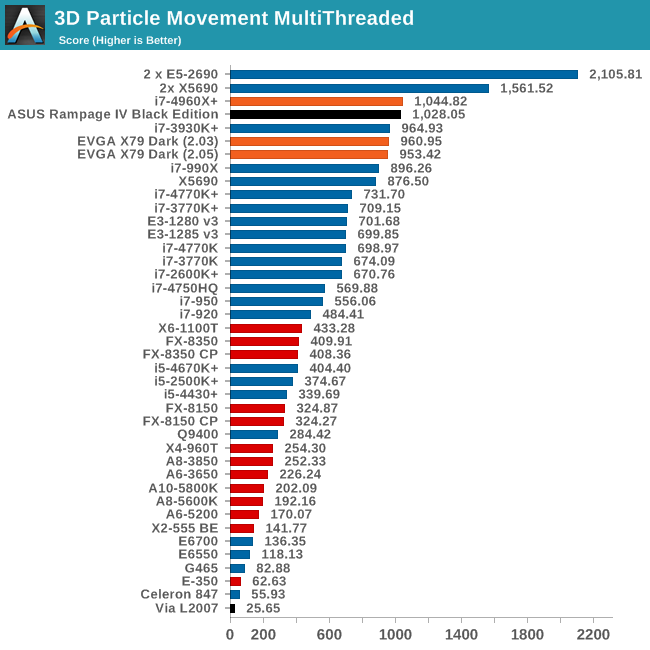
Compression - WinRAR 4.2
With 64-bit WinRAR, we compress the set of files used in the USB speed tests. WinRAR x64 3.93 attempts to use multithreading when possible, and provides as a good test for when a system has variable threaded load. WinRAR 4.2 does this a lot better! If a system has multiple speeds to invoke at different loading, the switching between those speeds will determine how well the system will do.
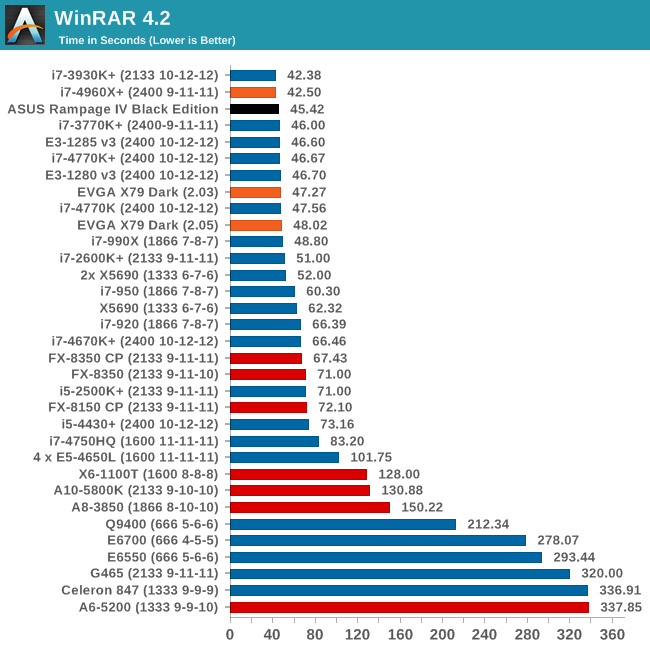
Image Manipulation - FastStone Image Viewer 4.2
FastStone Image Viewer is a free piece of software I have been using for quite a few years now. It allows quick viewing of flat images, as well as resizing, changing color depth, adding simple text or simple filters. It also has a bulk image conversion tool, which we use here. The software currently operates only in single-thread mode, which should change in later versions of the software. For this test, we convert a series of 170 files, of various resolutions, dimensions and types (of a total size of 163MB), all to the .gif format of 640x480 dimensions.

Video Conversion - Xilisoft Video Converter 7
With XVC, users can convert any type of normal video to any compatible format for smartphones, tablets and other devices. By default, it uses all available threads on the system, and in the presence of appropriate graphics cards, can utilize CUDA for NVIDIA GPUs as well as AMD WinAPP for AMD GPUs. For this test, we use a set of 33 HD videos, each lasting 30 seconds, and convert them from 1080p to an iPod H.264 video format using just the CPU. The time taken to convert these videos gives us our result.
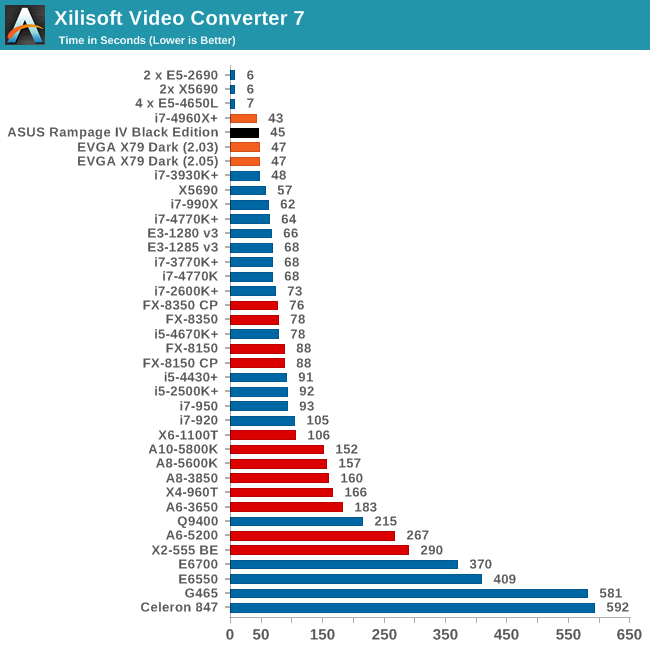
Rendering – PovRay 3.7
The Persistence of Vision RayTracer, or PovRay, is a freeware package for as the name suggests, ray tracing. It is a pure renderer, rather than modeling software, but the latest beta version contains a handy benchmark for stressing all processing threads on a platform. We have been using this test in motherboard reviews to test memory stability at various CPU speeds to good effect – if it passes the test, the IMC in the CPU is stable for a given CPU speed. As a CPU test, it runs for approximately 2-3 minutes on high end platforms.
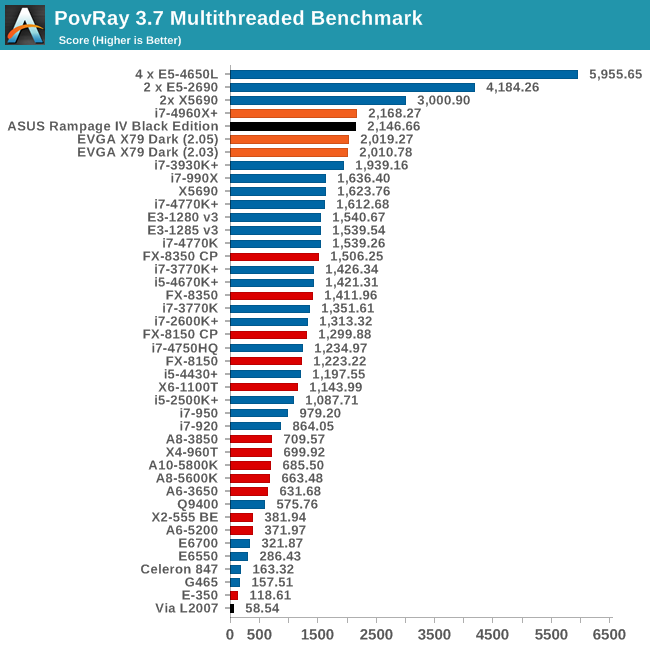
Video Conversion - x264 HD Benchmark
The x264 HD Benchmark uses a common HD encoding tool to process an HD MPEG2 source at 1280x720 at 3963 Kbps. This test represents a standardized result which can be compared across other reviews, and is dependent on both CPU power and memory speed. The benchmark performs a 2-pass encode, and the results shown are the average of each pass performed four times.
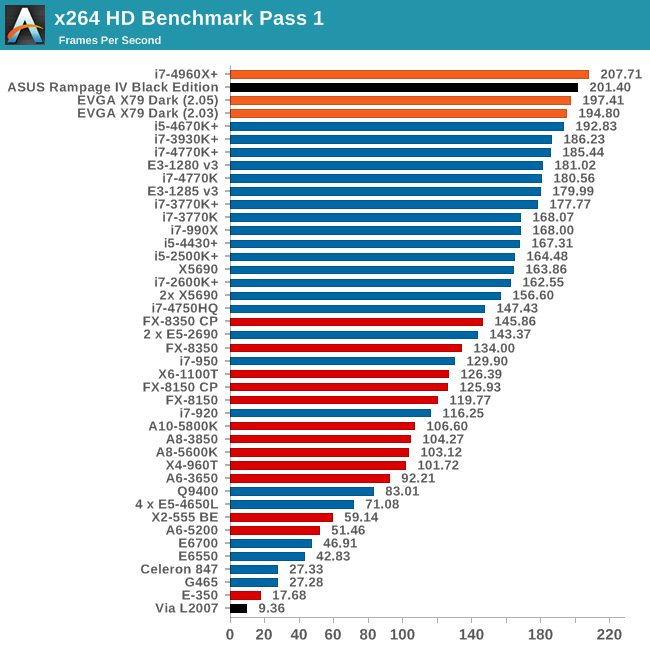
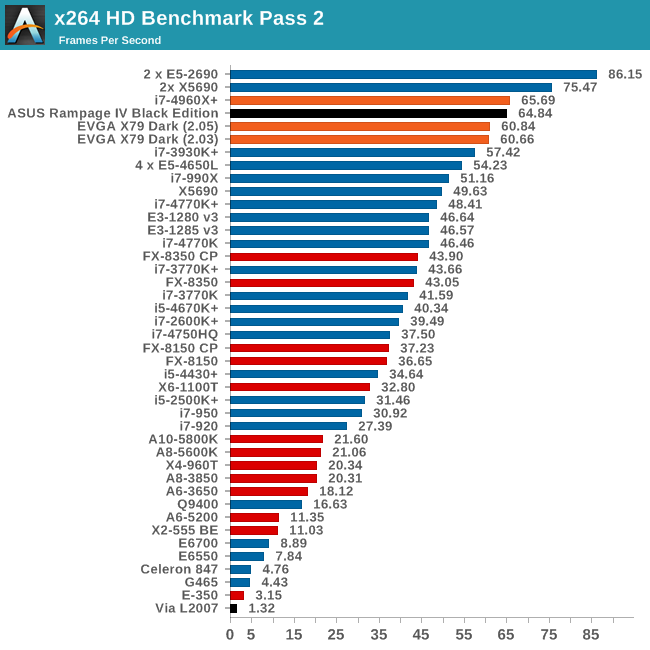
Grid Solvers - Explicit Finite Difference
For any grid of regular nodes, the simplest way to calculate the next time step is to use the values of those around it. This makes for easy mathematics and parallel simulation, as each node calculated is only dependent on the previous time step, not the nodes around it on the current calculated time step. By choosing a regular grid, we reduce the levels of memory access required for irregular grids. We test both 2D and 3D explicit finite difference simulations with 2n nodes in each dimension, using OpenMP as the threading operator in single precision. The grid is isotropic and the boundary conditions are sinks. Values are floating point, with memory cache sizes and speeds playing a part in the overall score.
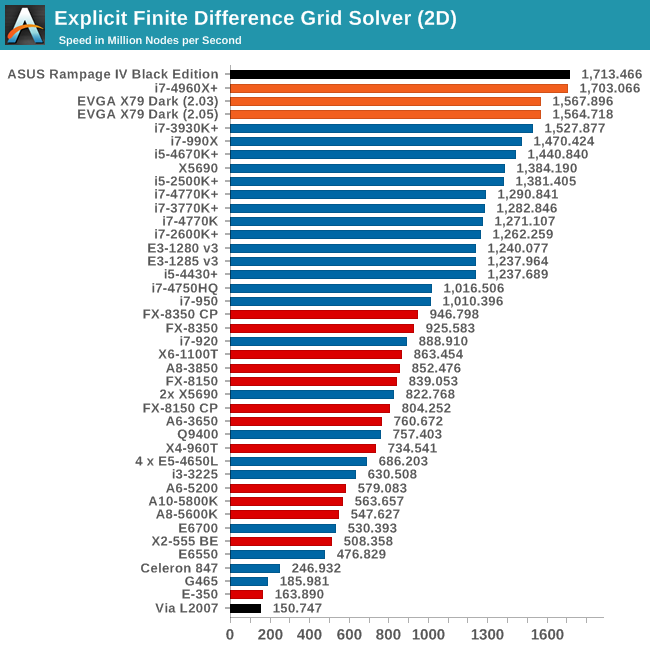
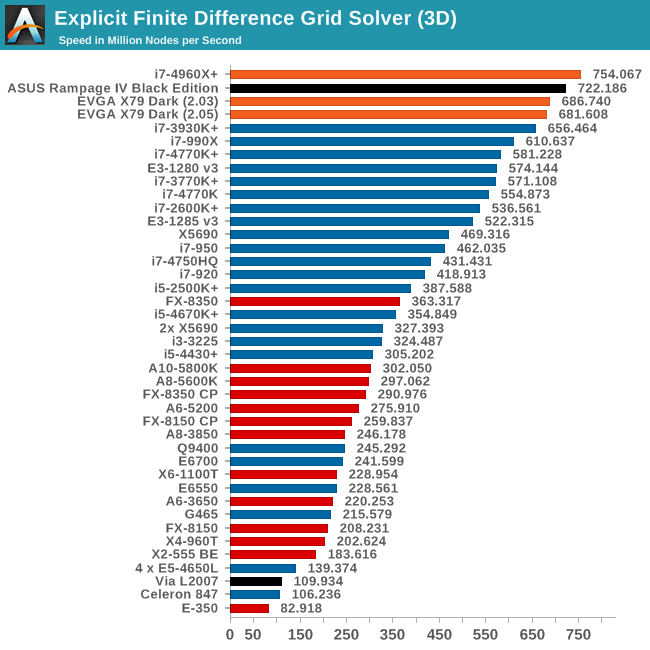
Grid Solvers - Implicit Finite Difference + Alternating Direction Implicit Method
The implicit method takes a different approach to the explicit method – instead of considering one unknown in the new time step to be calculated from known elements in the previous time step, we consider that an old point can influence several new points by way of simultaneous equations. This adds to the complexity of the simulation – the grid of nodes is solved as a series of rows and columns rather than points, reducing the parallel nature of the simulation by a dimension and drastically increasing the memory requirements of each thread. The upside, as noted above, is the less stringent stability rules related to time steps and grid spacing. For this we simulate a 2D grid of 2n nodes in each dimension, using OpenMP in single precision. Again our grid is isotropic with the boundaries acting as sinks. Values are floating point, with memory cache sizes and speeds playing a part in the overall score.
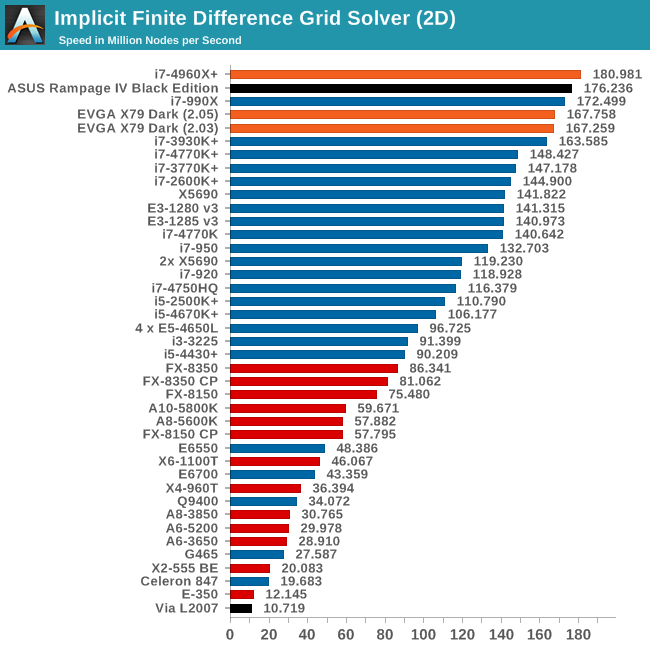
Point Calculations - n-Body Simulation
When a series of heavy mass elements are in space, they interact with each other through the force of gravity. Thus when a star cluster forms, the interaction of every large mass with every other large mass defines the speed at which these elements approach each other. When dealing with millions and billions of stars on such a large scale, the movement of each of these stars can be simulated through the physical theorems that describe the interactions. The benchmark detects whether the processor is SSE2 or SSE4 capable, and implements the relative code. We run a simulation of 10240 particles of equal mass - the output for this code is in terms of GFLOPs, and the result recorded was the peak GFLOPs value.
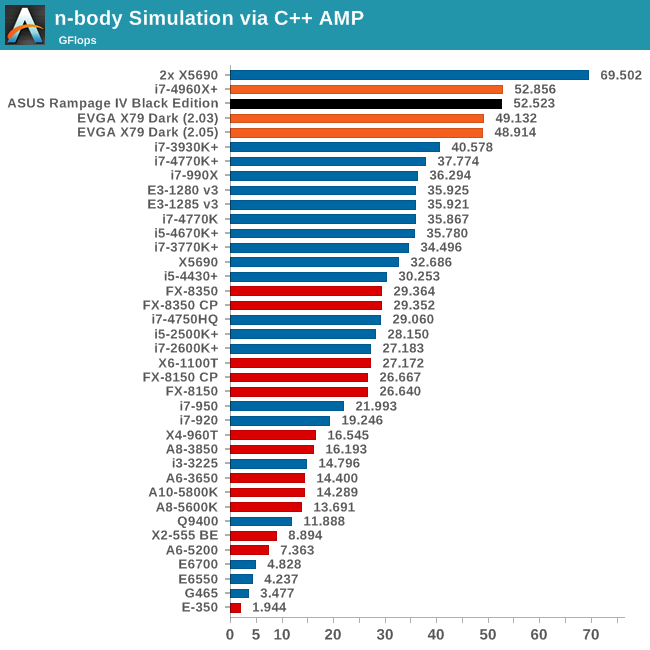










21 Comments
View All Comments
Origin64 - Sunday, January 5, 2014 - link
Thats some tasty pasta, my friend!bcg27 - Sunday, January 5, 2014 - link
After reading the article about smart phone audio analysis using the Audio Precision audio analyzer I was hoping to see some mobo audio results as well. Any chance of that happening?IanCutress - Sunday, January 5, 2014 - link
Top of page 5 for some basic audio tests using the board itself. I unfortunately do not have any AP hardware to do tests here. We're all scattered around the world, no big office to all draw on the same equipment.AssBall - Sunday, January 5, 2014 - link
The Gisele Blumchen of ivy bridge boards. So sexy. So out of my league. I struggle to justify Asus Deluxe series, which mind you are excellent. This is so over the top though.cactusdog - Monday, January 6, 2014 - link
Nice board but not for me. Intel should be shot for not upgrading the chipset. They expect you pay $1,000 for CPU and motherboard but the features are worse than 2 year old mainstream chipset.I always get the high end but sandy-e/ivy-e was a big letdown. Hopefully, Haswell-e will make the high end worthwhile again.
fluxtatic - Monday, January 6, 2014 - link
As regards the comment about this board missing Thunderbolt - is it just me, or has TB support fallen off a cliff? I honestly can't remember the last motherboard review I saw where it was mentioned the board had TB ports.Sabresiberian - Monday, January 6, 2014 - link
TYVM for adding sound analysis to your testing. :)toyotabedzrock - Tuesday, January 7, 2014 - link
Dare I ask what AliWangWang is? On page 2 there is a list of processes for setting up network priority.doggghouse - Tuesday, February 4, 2014 - link
I had to look it up... it's a chat program used for Taobao, which is sort of like eBay in China.sparkyuiop - Tuesday, January 21, 2014 - link
I bought 2 x AMD R9290 graphics cards for this but they don't clear the raised SATA ports or the north bridge chipset heatsink. Bummer!Don't try and mount the board in the corsair cases that have a rounded corner on the motherboard mounting panel, it don't go in! You can put 3 x double stand-offs at the SATA end 3 x single stand-offs at the I/O end and miss out screwing the middle fixings so as to slant the board but that's a bit shit when spending out the money for this hardware. So that's what I did!